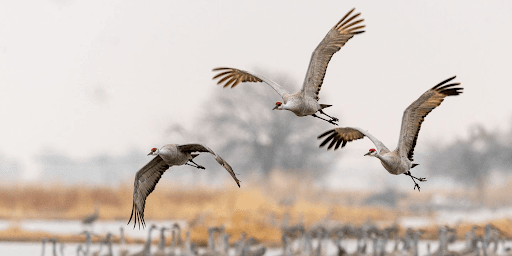
Nebraska: A Flyover State? Not for Sandhill Cranes
To many, Nebraska might be "flyover country," but for Sandhill Cranes, it's a crucial stopover. Each spring, nearly a million of these majestic birds descend upon the Platte River Valley to rest and refuel on their journey north. This magnificent migration draws visitors from around the world, eager to witness one of nature’s greatest spectacles.
Nebraska is the best place to experience this extraordinary migration. Between late February and early April, approximately 80% of the world’s Sandhill Crane population converges on the central Platte River Valley. Alongside them, millions of ducks and geese fill Nebraska’s rainwater basins, creating an unparalleled wildlife spectacle.
Ancient Travelers: The Sandhill Crane’s Legacy
Sandhill Cranes are among the oldest bird species on Earth. Fossil evidence suggests they were present in Nebraska over nine million years ago—long before the Platte River, which formed just 10,00 years ago.
Each year, cranes migrate from their wintering grounds in Mexico, Texas, and New Mexico to breeding grounds in Canada, Alaska, and even Siberia. Nebraska serves as a crucial layover, where they gain approximately 15% of their body weight, preparing for the final leg of their journey.
- Height: 3 to 4 feet
- Wingspan: 6 feet
- Weight: 8 to 12 pounds
- Color: Gray
- Daily Migration Distance: 170 to 450 miles
- Flight Speed: 38 mph
- Mating: 3 to 4 year
- Eggs laid per year: 2
- Population: approximately 1 million
Meet Their Tall Cousin: The Whooping Crane
North American Sandhill Cranes are the most abundant crane species in the world. However, their close relative, the Whooping Crane, is one of the rarest. These towering, snow-white birds were nearly driven to extinction in the early 20th century due to hunting and habitat loss. Thanks to conservation efforts, their numbers are slowly rebounding.
- Height: 6 feet
- Wingspan: 7 feet
- Weight: 15 pounds
- Color: White
- Daily Migration Distance: 250 miles/day
- Flight Speed: 35-40 mph
- Mating Age: 2-3 years
- Eggs laid per year: 1-3
- Population: Approximately 600
Witnessing the Migration: What to Expect
Sandhill Cranes begin arriving in Nebraska in late February, peaking in mid to late March. By early April, most have departed, though some linger into May. The timing of their migration is influenced by weather and climate, with scientists noting a gradual shift to earlier migration patterns over the years.
During their month-long stay, they:
- Roost in shallow river waters at night, gathering in dense flocks.
- Forage in nearby fields by day, consuming leftover corn nearly 1,600 tons of food!
- Perform courtship dances, strengthening lifelong bonds.
Cranes mate for life but will find a new partner if necessary. Juveniles remain with their parents for about a year before gaining independence.
Flight Technique: Cranes migrate using thermals, rising columns of warm air that allow them to soar effortlessly for hundreds of miles each day with minimal energy expenditure.
Where to See the Cranes in Nebraska:
Best Time: Early March to early April (sunrise and sunset are prime viewing times).
Top Locations:
- Crane Trust Nature & Visitor Center (Grand Island, NE) – Guided blind tours and VIP experiences.
Visit Grand Island >>> - Dusty Trails LLC (North Platte, NE) – Private guided blind and bus tours.
Dusty Trails >>> - Fort Kearny State Park (Kearney, NE) – Hike/bike bridge over the Platte River for public viewing.
Crane Watch Guide >>> - Rowe Sanctuary (Gibbon, NE) – Offers guided viewing tours and discovery stations.
Learn More >>>
Can’t Visit? Watch Live!
Experience the migration remotely via the Rowe Sanctuary live camera.
Watch Here
Interactive Crane Viewing Map
Nebraska Flyway Map
Tips for a Great Crane Viewing Experience
- Plan Ahead – Some locations require reservations or permits.
- Arrive Early – Best viewing times are sunrise and sunset.
- Bring Binoculars – Get an up-close view without disturbing the birds.
- Dress for the Weather – Conditions change rapidly, so be prepared.
- Photography Tips – Use a telephoto lens for crisp shots of cranes in flight.
- Respect Wildlife – Stay quiet and follow viewing guidelines.
A Natural Wonder Worth Experiencing:
Every spring, hundreds of thousands of tall, long-legged sandhill cranes embark on their migration north to breeding grounds in Alaska, Canada, and eastern Siberia. Approximately 80 percent of the world's sandhill cranes stop along Nebraska’s Platte River, where they refuel by feasting on leftover corn kernels from the previous fall’s harvest.
Their annual stop in Nebraska typically spans from mid-February to mid-April, with individual birds arriving and departing at different times. Each crane stays in the state for about a month, with their population reaching its peak in mid-March at around 500,000.
If you have the chance to witness the migration this year or in the future, take advantage of Nebraska’s rich wildlife and recreation. This breathtaking natural event is well worth the visit.

